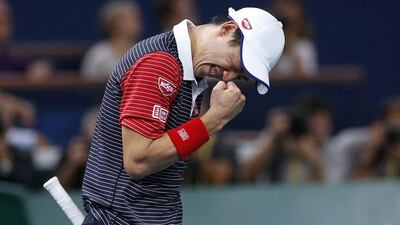If we’re looking for signs that the winds in the world of men’s tennis are indeed shifting, there’s a temptation to look at the 2014 ATP World Tour Finals field as something like a weathervane tilting ever so slightly.
Kei Nishikori, 24, and Milos Raonic, 23, are two of the rising young stars in the sport who muscled their way into this year’s end-of-season showcase for the first time.
At one point it looked like Bulgarian hotshot Grigor Dimitrov, 23, might also join them, and the 26-year-old US Open winner Marin Cilic will be on hand thanks to his surprise grand slam title.
The recent history of the event – the Tour Finals and before it the Tennis Masters Cup – offers a bit of caution against jumping too quickly to that conclusion, though.
There are plenty of examples of players who counted among the year-end elite at a young age without every really approaching the apex of the sport. There’s Andy Roddick, of course, who won the 2003 US Open and qualified for the Masters Cup at only 21. He was joined that year by 21-year-old Guillermo Coria, the eventual 2004 French Open finalist whose career was over by 2009.
David Nalbandian, too, was just 21 at the 2003 Masters Cup. He had a nice career, but certainly not an especially memorable one.
Juan Carlos Ferrero was 23 at the 2003 Masters Cup, in what turned out to be the midst of his own modest peak.
The list goes on: Marat Safin, 24 in 2004; Nikolay Davydenko, 24 in 2005; Richard Gasquet, 19 in 2007; Jo-Wilfried Tsonga, 23, Juan Martin del Potro, 20, and Gilles Simon, 24 in 2008; Robin Soderling, 25 in 2009; Tomas Berdych, 25 in 2010.
Fine pros all of them, but not a world-beater in the lot.
Of course, the 22-year-old champion in ‘03, Roger Federer, turned out okay. And in the following years guys named Nadal and Djokovic and Murray all turned up eventually, too.
Rather than year-end rankings, it might be instructive to see how a player fared against the ruling order of the time to know if they’re destined to continue rising.
In 2007, for instance, Djokovic managed to take two of his five contests against Federer, including in finals at Wimbledon and Indian Wells, before qualifying for the Masters Cup. Against Nadal he was 2-1, with Masters final wins in Miami and Rome.
When Murray arrived in 2008, he’d gone a plenty respectable 5-5 against the Big Three that year (and then beat Federer in the Masters Cup semis).
By that measure, our current crop of challengers seem to offer a little less promise. The Canadian Raonic went just 2-6 against what is now the Big 4 this year. Cilic was 2-5 himself, and each count one of those wins against Murray, who was out of form most of the year.
Nishikori was at least a bit better, going 2-5 (one of which was a walkover) with wins over Federer and Djokovic.
Unfortunately, London likely won’t offer much more clarity. Finishing with a flourish never signalled more to come for either Davydenko, the 2009 champion, or Nalbandian, the 2005 winner. Together they ever accounted for only five Masters titles and a solitary slam final appearance.
Instead, what Nishikori and Raonic and Dimitrov and even Cilic have going for them is that someone will inevitably have to rise to the fore. Federer is 33, Nadal has battled a slew of injuries and Murray is, to be blunt, very beatable these days.
Only Djokovic has consistently looked at the top of his game this year and, though he can appear so sometimes, he’s not invincible either.
To that end, Cilic’s random-seeming US Open title is as encouraging as anything.
But if this year’s ATP World Tour Finals don’t so much herald an explicit changing of the guard, Nishikori and Raonic and Cilic have a chance to offer a peek into how and when the guard might change.
After all, Federer’s 2003 title came against an old pro by the name of Andre Agassi.
Follow us on Twitter @SprtNationalUAE


